Like a B-grade horror film sequel, the aliens have awakened once again. Perhaps we felt a glimmer of hope at the end of the 2020 version when an entire generation of ruthless monsters died off in droves and left us in peace. But remember that closing shot of their disgusting, furry egg-mass blobs cleverly hidden out of sight? Well, they’re hatching now.
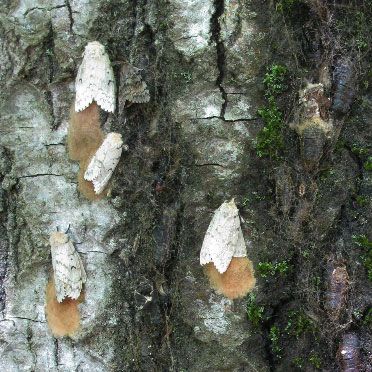
If you missed last year’s gypsy moth performance, you have a better chance of catching it this season. Unfortunately. Based on egg-mass sampling, the New York State Department of Environmental Conservation predicts that areas which saw moderate to severe gypsy moth outbreaks last year can expect heavy damage this year. NYSDEC’s gypsy moth page can be found here. In Ontario, the Ministry of Natural Resources and Forestry has the very same forecast. The full MNR report can be found here.

Native to Europe, the gypsy moth’s range now extends throughout Africa, Asia, and North America. Its genus, Lymantria, means “destroyer,” an apt designation, and its species name, dispar dispar, reflects the disparate color of males vs. females. It might as well stand for “despair, despair,” since that’s how many of us feel as we watch tree leaves vanish into the maws of gypsy moth caterpillars.
Their introduction in 1868 was especially tragic, as it was deliberate. Étienne Léopold Trouvelot, a French artist, astronomer and so-called scientist, imported gypsy moth egg masses to his Massachusetts home. He thought they could be used to make silk, despite good evidence to the contrary, and without a thought to their potential impact on New World ecosystems. Glass herbariums were safe but pricey, so he raised these fearsome defoliators in the woods behind his house. What could possibly go wrong?
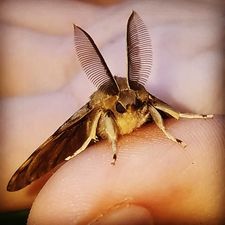
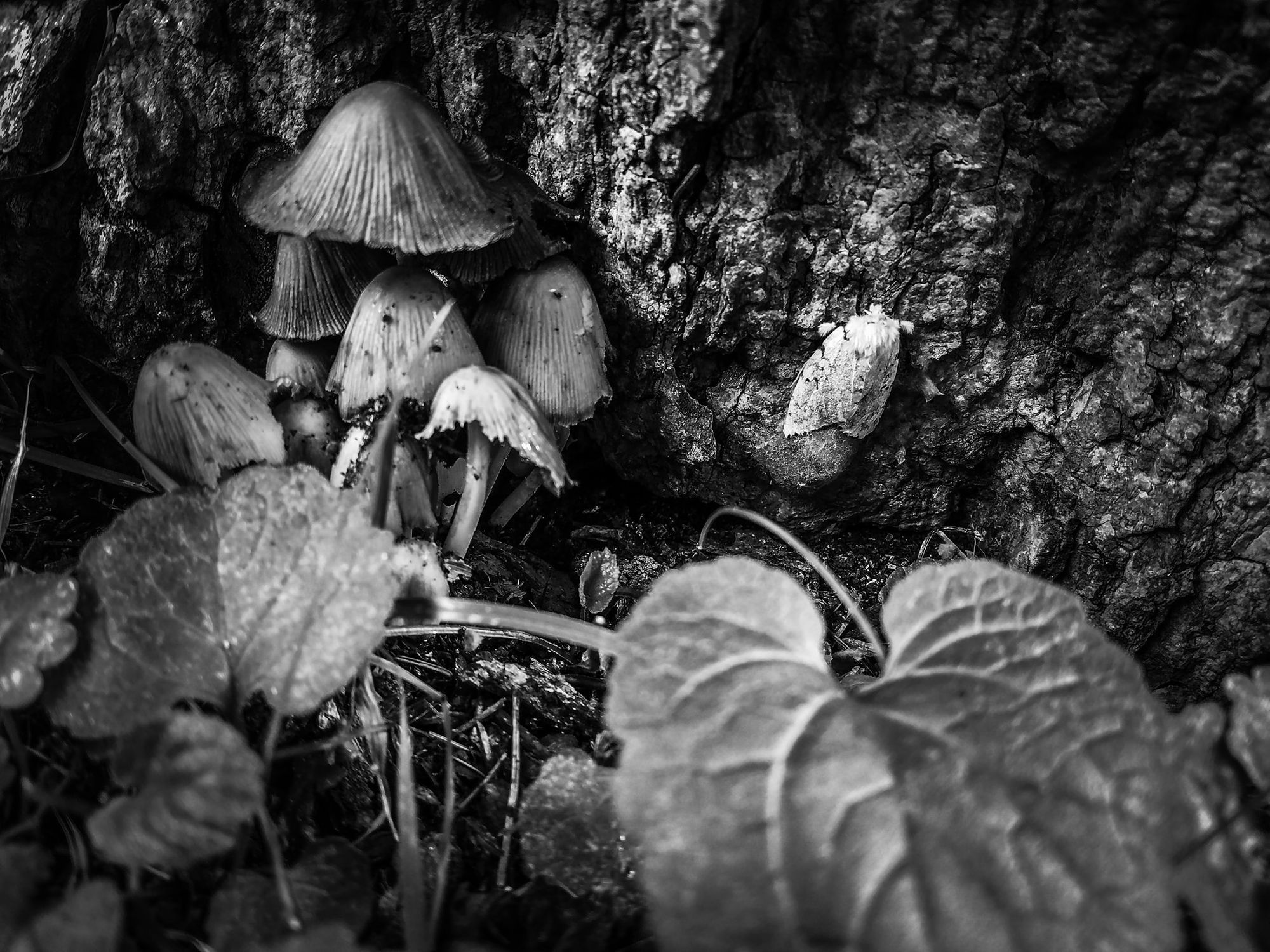
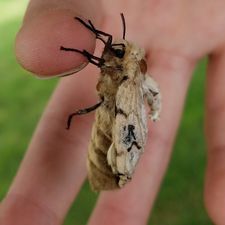
Today, gypsy moths are one of the most destructive forest pests in eastern North America, stripping the foliage off at least 300 species of native woody plants. They prefer oaks, but will feed on apple, pine, basswood, spruce, willow, and when population densities are high enough, almost any tree species. In an ironic twist now that EAB is here, gypsy moth caterpillars generally avoid ash. Butternut, walnut and balsam are typically off the menu, too.
Hatchling larvae are black with long hairs, or setae. As the larvae grow, they molt, shedding skins every time they advance to another phase (instar). Later-instar caterpillars develop pairs of raised blue (nearer the head) and dark red (toward the rear) spots along their backs, reaching maturity in early July. After a 14-17-day pupal phase, the adult moths emerge. The mostly-white females can’t fly from where they emerged, and just call out to the boy-moths, which are mottled brown, using pheromone come-on signals. Mated females lay on average around 500 eggs in a “blob” or mass, which they protect with buff-colored hairs taken from their underside.
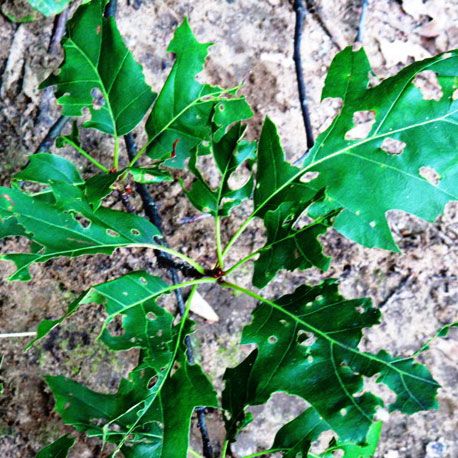
These oval-shaped egg masses, tan to cream in color and about 0.75 x 1.5 inches (19 x 38 mm), can be found tucked away near whatever hiding spot the female pupated in. Very often laid on tree trunks and notably under flaps of loose bark, egg masses are usually in sheltered spots, but may be just about anywhere. Right now in early May, tiny hatchlings can be found clustered on these masses – it’s a great time to seek and destroy.
Natural predators include blue jays, robins and catbirds, but these have no measurable effect on gypsy moth numbers. The white-footed mouse, the primary reservoir of the three species of Borrelia spirochete bacteria that cause Lyme disease, has redeemed its reputation: it’s the most important vertebrate gypsy moth control, as it loves eating their egg masses. Shrews and other small mammals enjoy hearty breakfasts of gypsy moth eggs, too.
More significant agents are weather, viruses and fungi. As with the tent caterpillar species, prolonged wet, cool weather can lead to hatchling starvation, and a sudden cold snap in late fall or early winter can kill eggs before the embryos inside can winterize their cells. Cool temps also favor infection by fungal pathogens, as explained below.
An endemic soil fungus, nicknamed Entomophaga maimaiga for short, kills gypsy moth caterpillars as their populations rise. But NPV (nucleopolyhedrosis virus) is our MVP when it comes to knocking defoliator numbers down. The catch is that this naturally occurring virus usually takes two years to precipitate a gypsy moth population crash.
In addition to egg-mass mashing, we can smother eggs that we can’t reach with a shot of dormant-oil spray. This is a very light, highly refined horticultural oil. Some people use aerosol non-stick cooking oil such as Pam, although strictly speaking, this might not be legal. (I promise not to tell.)

Applications of Bacillus thuringiensis kurstaki, or Btk to its pals, will protect foliage. Found at any garden center, preparations of Btk contain a natural toxin produced by these bacteria. It is highly specific to caterpillars and considered safe for other terrestrial and aquatic life. It must be ingested to have an effect. It does wash off, so re-apply after it rains.
Wrapping trunks with a 6” fabric strip, and then smearing it with a sticky compound made for the purpose of trapping insects (Tanglefoot and other brands) will trap larvae, which tend to commute down to the ground at night and back to the treetops in the morning. A “skirt” of burlap tied around trunks will draw caterpillars to take shelter under the fabric, and they can be squished or knocked into soapy water daily. (Caution: the hairs can cause skin rashes and sometimes upper-respiratory irritation.)
Also, never move firewood! Unless it’s from the woodpile to the house – that’s OK. Bringing firewood from home to cottage (or vice-versa) is the best way to spread infestations of all sorts of pests.
Healthy deciduous trees can re-foliate after being stripped of leaves, but at great cost to their energy budgets. Pines and spruces, on the other hand, are not endowed with re-foliation powers. They’re left with only a smattering of green razor stubble with which to photosynthesize; thus, gypsy moths can cause such conifer species grave harm. When defoliation occurs in successive years, tree mortality becomes a concern.
Don’t be shy about scouring the back yard in the coming days for egg masses to squish, and it’s probably a good idea to stock up on Btk before the June rush when everyone begins to notice the caterpillars. Let’s hope there’s no remake next year. For more information, see NYSIPM’s gypsy moth resource page.
[Header photo © Queen’s Printer for Ontario, 2014. Reproduced with permission]
Paul Hetzler
Paul Hetzler is an ISA-Certified Arborist and a former Cornell Cooperative Extension Educator.
Editor's note:
If you like Paul Hetzler's writing, then you must get his book, Shady Characters: Plant Vampires, Caterpillar Soup, Leprechaun Trees and Other Hilarities of the Natural World." It is available on amazon.com, amazon.ca (Canadian), and the convenient Amazon.com (Kindle). Once you get it, let me know how many times you smiled and/or laughed out loud... As well, see Paul's other TI Life submissions here: https://thousandislandslife.com/author/paul-hetzler/

Posted in: Volume 16, Issue 6, June 2021, Nature
Please click here if you are unable to post your comment.
